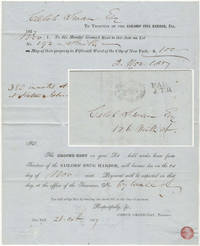Invoice-sent via Boyd's City Express-for property rental to support the Sailors' Snug Harbor, one of the first charitable organizations in the United States by Joseph Greenleaf to Caleb Swan - 1857
by Joseph Greenleaf to Caleb Swan

Invoice-sent via Boyd's City Express-for property rental to support the Sailors' Snug Harbor, one of the first charitable organizations in the United States
by Joseph Greenleaf to Caleb Swan
- Used
- very good
New York, 1857. Envelope or Cover. Very good. This invoice was sent by Joseph Greenleaf, the Treasurer of Sailors' Snug Harbor on Staten Island to Caleb Swan at 126 Ninth Street. It is dated 28 October 1857 and bills Swan $100 for "Six Months Ground Rent". It bears a somewhat blurred Boyd's City Express postmark dated October 29 along with a "PAID J.T.B." handstamp. The invoice has an annotation that reads, 380 inmates at the Asylum of Staten Island". The invoice is in nice shape. Sailors' Snug Harbor was founded by a retired ship captain, Robert Richard Randall. He had inherited a huge estate from his father, another sea captain, who had amassed a fortune as a privateer during the French and Indian War and the American Revolution. After Captain Tom retired from sailing, he became a prominent New York merchant, and upon his death, Richard took over the business. In 1790, Richard purchased the 24-acre "Minto Farm" in what is now Greenwich Village, where he built a large manor house. When he died in 1817, Robert specified in his will that the Minto Farm property was to be used by the Marine Society to create a "snug harbor," a marine hospital for "the purpose of maintaining aged, decrepit, and worn-out sailors." Robert's intent was that its "inmates" (i.e., residents) would live in the manor house and grow sufficient food on the farm to support themselves. By the time challenges to his will were resolved in 1831, the Marine Society had determined that it would make far more economic sense to open a much larger Snug Harbor on a 160-acre complex on Staten Island, and subdivide the Minto Farm land into rental properties as the area surrounding Washington Square Park had become especially popular with well-to-do New Yorkers. Row houses, apartments, and studios were built on the property to lease, and the rents received were far in excess of its expenses. By 1899, the charity reported an income of nearly $500,000 while expenses hovered at $200,000. At its peak, Snug Harbor was home to over 1,000 sailors, however by the 1960s almost no sailors remained at the complex. It closed in 1965, and much of the property was purchased by Staten Island to serve as a cultural center. For more information see Morris's Memorial History of Staten Island, and Feighery's "Robert Richard Randall and Sailors' Snug Harbor" at VCU Libraries Social Welfare Project.) Caleb Swan rented a three-story brick building that the charity had built on Ninth Street where he established a commission merchant business. Boyd's City Express was one of the first local post offices in the United States delivering intracity mail several times daily within New York City. It faced continual harassment from the U.S. Post Office from the time it opened in 1844 until it closed in 1885, shortly after a raid by postal authorities. (For more information see Bowman's "A Primer on Boyd's City Express Post" at pennypost.com.).
-
Bookseller
Kurt A. Sanftleben, LLC
(US)
- Format/Binding Envelope or Cover
- Book Condition Used - Very good
- Quantity Available 1
- Place of Publication New York
- Date Published 1857